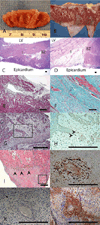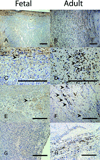Regenerative healing following foetal myocardial infarction
- PMID: 20452780
- PMCID: PMC2921018
- DOI: 10.1016/j.ejcts.2010.03.049
Regenerative healing following foetal myocardial infarction
Abstract
Objectives: The adult response to myocardial infarction results in inflammation, scar formation, left ventricular dilatation, and loss of regional and global function. Regenerative scarless healing has been demonstrated in foetal dermis and tendon and is associated with diminished inflammation. We hypothesised that following foetal myocardial infarction, there would be minimal inflammation, regenerative healing, and preservation of function.
Methods: Anteroapical myocardial infarction encompassing 20% of the left ventricle was created in adult or early gestation foetal sheep. Myocardial function was serially assessed using quantitative echocardiography. Infarct architecture was examined histologically for evidence of scar formation. Cellular inflammation, cellular proliferation, and apoptosis were assessed using immunohistochemistry.
Results: In the adult sheep 4 weeks following myocardial infarction, there was a significant decline in ejection fraction (EF) (41±7.4% to 26±7.4%, p<0.05), and the akinetic myocardial segment increased in size (6.9±0.8 cm to 7.9±1.1 cm, p<0.05). By contrast, there was no decline in the foetal EF (53±8.1% to 55±8.8%) and no akinetic foetal myocardial segment 4 weeks post-infarction. The foetal infarcts lacked an inflammatory cell infiltrate and healed with minimal fibrosis, compared with the adults. Foetal infarcts also demonstrated 5-bromo-2'-deoxyuridine (BrdU)+ proliferating cells, including cardiomyocytes, within the infarct.
Conclusions: These data demonstrate that the foetal response to myocardial infarction is dramatically different from the adult and is characterised by minimal inflammation, lack of fibrosis, myocardial proliferation and restoration of cardiac function. Diminished inflammation is associated with foetal regenerative cardiac healing following injury. Understanding the mechanisms involved in foetal myocardial regeneration may lead to applications to alter the adult response following myocardial infarction.
Copyright © 2010 European Association for Cardio-Thoracic Surgery. Published by Elsevier B.V. All rights reserved.
Figures




Similar articles
-
Mammalian fetal cardiac regeneration after myocardial infarction is associated with differential gene expression compared with the adult.Ann Thorac Surg. 2014 May;97(5):1643-50. doi: 10.1016/j.athoracsur.2014.01.013. Ann Thorac Surg. 2014. PMID: 24792251 Free PMC article.
-
Mammalian cardiac regeneration after fetal myocardial infarction requires cardiac progenitor cell recruitment.Ann Thorac Surg. 2013 Jul;96(1):163-70. doi: 10.1016/j.athoracsur.2013.04.005. Ann Thorac Surg. 2013. PMID: 23816072 Free PMC article.
-
Infarct size reduction and attenuation of global left ventricular remodeling with the CorCap cardiac support device following acute myocardial infarction in sheep.Heart Fail Rev. 2005 Jun;10(2):125-39. doi: 10.1007/s10741-005-4640-2. Heart Fail Rev. 2005. PMID: 16258720
-
Inflammatory mechanisms in myocardial infarction.Curr Drug Targets Inflamm Allergy. 2003 Sep;2(3):242-56. doi: 10.2174/1568010033484098. Curr Drug Targets Inflamm Allergy. 2003. PMID: 14561159 Review.
-
Post-infarct cardiac injury, protection and repair: roles of non-cardiomyocyte multicellular and acellular components.Sci China Life Sci. 2018 Mar;61(3):266-276. doi: 10.1007/s11427-017-9223-x. Epub 2018 Jan 23. Sci China Life Sci. 2018. PMID: 29388041 Review.
Cited by
-
The role of microRNA-146a in the pathogenesis of the diabetic wound-healing impairment: correction with mesenchymal stem cell treatment.Diabetes. 2012 Nov;61(11):2906-12. doi: 10.2337/db12-0145. Epub 2012 Jul 30. Diabetes. 2012. PMID: 22851573 Free PMC article.
-
Biomaterial-mediated modification of the local inflammatory environment.Front Bioeng Biotechnol. 2015 May 15;3:67. doi: 10.3389/fbioe.2015.00067. eCollection 2015. Front Bioeng Biotechnol. 2015. PMID: 26029692 Free PMC article. Review.
-
Identification of Novel miRNAs Involved in Cardiac Repair Following Infarction in Fetal and Adolescent Sheep Hearts.Front Physiol. 2020 Jun 10;11:614. doi: 10.3389/fphys.2020.00614. eCollection 2020. Front Physiol. 2020. PMID: 32587529 Free PMC article.
-
Regulation of microRNA during cardiomyocyte maturation in sheep.BMC Genomics. 2015 Jul 22;16(1):541. doi: 10.1186/s12864-015-1693-z. BMC Genomics. 2015. PMID: 26198574 Free PMC article.
-
Bearing My Heart: The Role of Extracellular Matrix on Cardiac Development, Homeostasis, and Injury Response.Front Cell Dev Biol. 2021 Jan 12;8:621644. doi: 10.3389/fcell.2020.621644. eCollection 2020. Front Cell Dev Biol. 2021. PMID: 33511134 Free PMC article. Review.
References
-
- Yang Z, Day YJ, Toufektsian MC, Xu Y, Ramos SI, Marshall MA, French BA, Linden J. Myocardial infarct-sparing effect of adenosine A2A Receptor Activation is due to its action on CD4+ T lymphocytes. Circulation. 2006;114:2056–2064. - PubMed
-
- St. John Sutton M, Sharpe N. Left ventricular remodeling after infarction: pathophysiology and therapy. Circulation. 2000;101:2981–2988. - PubMed
-
- Cleutjens JPM, Kandala JC, Guarda E, Guntaka RV, Weber KT. Regulation of collagen degradation in the rat myocardium after infarction. J Mol Cell Cardiol. 1995;27:1281–1292. - PubMed
-
- Takahashi T, Hiasa Y, Ohara Y, Miyazaki S, Ogura R, Miyajima H, Yuba K, Suzuki N, Hosokawa S, Kishi K, Ohtani R. Relation between neutrophil counts on admission, microvascular injury, and left ventricular functional recovery in patients with an anterior wall first acute myocardial infarction treated with primary coronary angioplasty. Am J Cardiol. 2007;100:35–40. - PubMed
-
- Åströ-Olsson K, Hedström E, Hultén LM, Wiklund O, Arheden H, Öhlin AK, Gottsäter A, Öhlin H. Dissociation of the inflammatory reaction following PCI for acute myocardial infarction. J Invasive Cardiol. 2007;19:452–456. - PubMed
Publication types
MeSH terms
Grants and funding
LinkOut - more resources
Full Text Sources
Medical

